“Black shapes were emerging out of thin air all around them, blocking their way left and right; eyes glinted through slits in hoods, a dozen lit wand-tips were pointing directly at their hearts” (Rowling, OOTP 781).
There is a noticeable increase in Death Eater appearance in the later books. The increase links to Harry’s age. As Harry grows, Voldemort grows, and the storyline continues to set up to their inevitable battle. From the fourth year on, Lord Voldemort’s rise to power provides increased Death Eater presence. When he rises to power, they rise in prevalence. Some are more open about their involvement and admiration for the Dark Lord (Bellatrix is the number one Voldemort fan, whereas Snape is a bit of a lukewarm and hidden fan), but most remain cloaked in the shadows.
Although the ministry initially ignores Harry’s warning about Lord Voldemort’s resurgence and the Death Eaters, the reader knows how much activity is happening within the group. The events that take place from the fourth year on are a part of the “Second Wizarding War.” The Death Eaters were still a bit of a secret in the fourth book. However, they begin regaining public presence after their attack at the Quidditch World Cup. After Voldemort becomes strong enough to inhabit a “human” form, and appears in the Little Hangleton graveyard, the group reconnects.
In the Order of the Phoenix, the Death Eaters are mentioned in a “mass breakout from Azkaban” warning, with a list of escapees including Dolohov, Rookwood, and Bellatrix. The Death Eaters begin coming out of the shadows. Later in the book, they make a noticeable appearance at the Ministry of Magic in the Department of Mysteries. Under Voldemort’s commands, a group of twelve Death Eaters attempt to take the prophecy. In this battle, Bellatrix kills Sirius, and almost kills Hermione. Afterward, the Ministry is forced to recognize the threat that the newly risen Lord Voldemort has over the wizarding world.
In the Half Blood Prince, Death Eater presence experiences a similar and steady rise. Voldemort’s gain in power results in a gain in planning, and the reader sees the various meetings with the Death Eaters. The Malfoy Manor becomes a type of headquarters for meeting as well as muggle torture. With increased threat, Hogwarts experiences an increase in students forced out of school. The peak of the sixth year Death Eater battle (sometimes referred to as the Battle of the Astronomy Tower) ends with Dumbledore’s death. This leads to extended Death Eater control over Hogwarts, another necessary step to gain influence in addition to their Ministry infiltration.
The last book contains an overflow of Death Eater activity, which is explained in detail on our timeline. In broad strokes, the largest battle of the Second Wizarding War that includes the most Death Eater activity is the Battle of Hogwarts. It is the ending battle of the war, and kills a large number of Death Eaters, including Snape and Bellatrix. Voldemort is also killed, and in the end, the remaining Death Eaters retreat back into the shadows.
Rowling, J.K. Harry Potter and the Deathly Hallows. New York: Scholastic, 2007. Print.
Rowling, J.K. Harry Potter and the Goblet of Fire. New York: Scholastic, 2000. Print.
Rowling, J.K. Harry Potter and the Half-Blood Prince. New York: Scholastic, 2005. Print.
Rowling, J.K. Harry Potter and the Order of the Phoenix. New York: Scholastic, 2003. Print.
